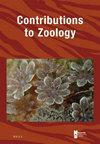A new species of Potamonautes from São Tomé Island, Central Africa, with redescriptions of P. margaritarius (A. Milne-Edwards, 1869) from São Tomé, and P. principe Cumberlidge, Clark and Baillie, 2002, from Príncipe (Decapoda: Potamonautidae)
IF 2.2
2区 生物学
Q1 ZOOLOGY
引用次数: 0
Abstract
Surveys of the freshwater crabs of two islands in the Gulf of Guinea, Central Africa, allowed a revision of the taxonomy of two little-known island endemic species, based for the first time on adult males: Potamonautes margaritarius (A. Milne-Edwards, 1869) from São Tomé, and of P. principe Cumberlidge, Clark and Baillie, 2002, from Príncipe (Brachyura; Potamonautidae). A new species of Potamonautes from southern São Tomé (Potamonautes saotome sp. nov.) is also described that is genetically distinct and has a clearly separate geographic distribution from P. margaritarius from northern São Tomé. The new species from southern São Tomé can be recognized by a suite of characters of the carapace, thoracic sternum, and gonopods. The taxonomy of P. margaritarius (A. Milne-Edwards, 1869) is stabilized by selecting a neotype from northern São Tomé. Potamonautes principe from Príncipe is the most distinct of the three taxa, with a more swollen carapace that has smooth anterolateral margins, and a shorter, straighter male first gonopod. All three taxa are morphologically distinct species that have also been clearly distinguished as evolutionarily separate lineages by mtDNA analysis and haplotyping in an earlier study. Previous phylogenetic evidence supports two separate island colonization events at different times in the past from different ancestral populations, one to São Tomé and another to Príncipe that resulted in the establishment of the endemic freshwater crab faunas of these two islands.一种产于中非圣多美岛的Potamonates新种,对圣多美岛的P.margaritarius(A.Milne Edwards,1869)和Príncipe的P.principe Cumberridge,Clark和Baillie,2002进行了重新描述(十足目:Potamonatidae)
对中非几内亚湾两个岛屿淡水蟹的调查,使两个鲜为人知的岛屿特有物种的分类得以修订,首次以成年雄性为基础:来自 o tom的Potamonautes margaritarius (a . Milne-Edwards, 1869年)和p.p principe Cumberlidge, Clark和Baillie, 2002年,来自Príncipe (Brachyura;Potamonautidae)。本文还报道了一种来自 o tom南地区的新种Potamonautes (Potamonautes saoome sp. nov.),它与来自 o tom北地区的P. margaritarius具有明显的遗传差异和地理分布。该新种来自南部的东岛,可以通过甲壳、胸骨和性腺的一系列特征来识别。通过从 o tom北部选择一个新种,稳定了P. margaritarius (a . Milne-Edwards, 1869)的分类。来自Príncipe的Potamonautes principe是三个分类群中最明显的,有一个更肿胀的甲壳,有光滑的前外侧边缘,和一个更短、更直的雄性第一性腺。这三个类群在形态上是不同的物种,在早期的研究中,通过mtDNA分析和单倍型分析,它们也被清楚地区分为进化上不同的谱系。先前的系统发育证据支持在过去不同时间发生的两次独立的岛屿殖民事件,一次是来自不同祖先的种群,一次是到 o tom岛,另一次是到Príncipe岛,这导致了这两个岛屿特有的淡水蟹群的建立。
本文章由计算机程序翻译,如有差异,请以英文原文为准。
求助全文
约1分钟内获得全文
求助全文
来源期刊

Contributions to Zoology
生物-动物学
CiteScore
4.00
自引率
4.50%
发文量
16
审稿时长
>12 weeks
期刊介绍:
Contributions to Zoology solicits high-quality papers in all systematics-related branches of comparative zoology (including paleozoology). Preference will be given to manuscripts dealing with conceptual issues and to integrative papers (e.g., ecology and biodiversity, morphology and phylogeny and character state evolution, phylogeny and historical biogeography, systematics and bioinformatics, bioinformatics and biodiversity, habitat disturbance and biogeography, etc.). Reviews and alpha-taxonomic contributions are considered for publication, but acceptance will depend on their high quality and exceptional nature.
 求助内容:
求助内容: 应助结果提醒方式:
应助结果提醒方式:


